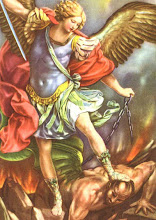What did Luther say? Jesus and Mary Magdalene
Matthew Becker
A recent New Yorker article on Mary Magdalene, obviously written with an eye on her role as Jesus' paramour in Dan Brown's best-selling The Da Vinci Code, began by noting that "Brown is by no means the first to have suggested that Christ had a sex life--Martin Luther said it" (February 13-20). Bruce Chilton, an Episcopal scholar from Bard College, also makes this claim about Luther in Mary Magdalene: A Biography (2005). And a 2003 story in Time magazine declared that "Martin Luther believed that Jesus and Mary Magdalene were married."
Did Luther really make these assertions? An electronic search of the digital edition of Luther's works, the massive Weimar Ausgabe (WA), uncovers no evidence that he did. Only two statements come even close to suggesting these unorthodoxies.
The first is a comment on Psalm 119:145 in which Luther interprets Mary Magdalene's actions at the tomb of Christ as an example of loving devotion. Mary "came beforehand at the dawn and with untimely haste and cried and called for her betrothed [sponsum] much more wonderfully in spirit than in the body. But I think that she alone might easily explain the Song of Songs."
Luther's Works: American Edition (LW) unfortunately mistranslates sponsum as "husband." In Luther's medieval monastic context, the word meant something different. The verb spondeo means "to pledge oneself to" or "to promise oneself to someone," as in "to pledge in the vow of marriage." The male form of the noun is "fiance" and the female form is "bride."
The full context of Luther's remark indicates that he was thinking allegorically. Influenced by mainstream allegorical interpretations of the Song of Songs, Luther viewed Mary as the prototypical disciple (a celibate nun?), the first "bride of Christ," who had made her vow of unconditional love and obedience to her sponsum ("betrothed," "groom"). Even today Roman Catholic nuns wear a ring to symbolize their betrothal to Christ. On another occasion Luther argued that all Christians are "brides of Christ" (LW 28:48). He certainly did not think Jesus and Mary were actually husband and wife. Several unambiguous statements in his writings clearly indicate that he held the traditional view that Jesus, like Paul, was celibate and chaste.
Seemingly more problematic is a small notation from John Schlagenhaufen, one of Luther's close friends, which contains a recollection of something Luther supposedly said informally at his Wittenberg dinner table in 1532:
Christ [as] adulterer. In the first instance
Jesus became an adulterer
with the woman at the well in John
4, because they say (no one understands),
"What is he doing with
her?" In the same way with Magdalena;
in the same way with the
adulteress of John 8, whom he let
off so easily. In that way the godly
Christ first of all must also become
an adulterer before he died. (WA
TR 6, 107, sec. 1472; cf. LW 54:154)
No one knows if Luther actually said this. The critical apparatus in the Weimar Ausgabe reveals the textual and grammatical problems in this supposed quotation. Schlagenhaufen recorded only a portion of what he remembered Luther to have said that day (and after how many beers?). No context is given.
Scholars know how difficult, if not impossible, it is to link the lapidary "table notations" of Luther's friends to Luther's own views. The editors of the American Edition speculate in a footnote that the "probable context is suggested in a sermon of 1536 (WA 41, 647) in which Luther asserted that Christ was reproached by the world as a glutton, a winebibber, and even an adulterer" (LW 54:154).
A more probable context is Luther's account of the atonement. One of his basic assertions is that our sins become Christ's and Christ's perfect righteousness becomes ours by faith. This idea of "the happy exchange" is found in many Luther texts. Given his central soteriological and christological concern, the theological irony in Schlagenhaufen's remembered notation becomes clearer: The "godly" Christ becomes or is made a sinner through his solidarity with sinners, even to the point of dying as a God-forsaken criminal on the cross. This is how Luther understood Paul's statement, "God made him who knew no sin to be sin for us so that in him we might become the righteousness of God" (2 Cor. 5:21).
So Christ "becomes" an adulterer, though he does not actually commit adultery with Mary or anyone else. He puts mercy front and center, and rejects the legalism which demanded that the woman caught in adultery be killed and the woman at the well and Mary Magdalene be shunned. The holy one becomes the sinner by putting himself into the situation of sinners, by loving and forgiving them, and ultimately by taking their sins on himself. For this gospel reason, Luther could also remark that God made Jesus "the worst sinner of the whole world," even though he also acknowledged that the sinless, righteous Christ actually committed no sin himself.
Trapped in a literalistic approach to Schlagenhaufen's contextless note, some readers have missed the metaphorical character of the remark, which Luther may have made, if he made it at all, with a twinkle in his eye. I'm confident that Luther would not be a fan of The Da Vinci Code--except perhaps with a beer in hand and that twinkle in his eye.
Matthew Becker teaches theology at Valparaiso University.
COPYRIGHT 2006 The Christian Century Foundation
COPYRIGHT 2006 Gale Group
ARTICLES AGAINST DA VINCI CODE
Iscriviti a:
Commenti sul post (Atom)


Nessun commento:
Posta un commento